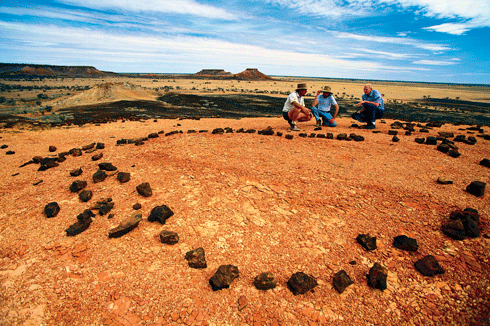
|
Published: 9 March 2011
Strong links to land deliver better health outcomes
Around the time the Prime Minister’s ‘Closing the Gap’ report was released in February, the Desert Knowledge Cooperative Research Centre (CRC) published a comprehensive report outlining four principles for Aboriginal land management. Researchers say these principles will help improve health and well-being for indigenous communities.
The ‘Closing the Gap’ report raised particular concerns about achieving one of the six key targets – closing the life expectancy gap between Aboriginal and non-Aboriginal Australians – which is currently 11.5 years for men and 9.7 years for women. The report noted that while the life expectancy of indigenous people increased over 1991–2008, the ‘gap’ may not close for some years, because the life expectancy of non-indigenous people has been rising at a faster rate.1
For Aboriginal communities in inland Australia at least, connections with land can help them achieve a better state of health, says Dr Jocelyn Davies of CSIRO Ecosystem Sciences – lead author of the Desert Knowledge CRC report.2 Dr Davies and her colleagues formulated four ‘Livelihoods inLand™’ principles after analysing a large body of published scientific work.3
‘Aboriginal people commonly say that their health and well-being are positively impacted by a strong relationship with their traditional lands and culture, and there is increasing scientific evidence that this is the case,’ says Dr Davies.
‘People’s sense of control or capacity to cope, and the serious health impacts of sustained stress, are powerful factors explaining this relationship. The stress load on Aboriginal people is reduced when they are empowered through caring for their own lands.’
A team headed by Mr David Campbell, senior economist at the Centre for Remote Health, has identified potential positive health impacts of Aboriginal involvement in land management. Mr Campbell’s team estimated that a health centre in a northern Australian community of 1200 people saves about $270 000 annually (or a net present value of $4 million) in primary treatment costs for hypertension, renal disease and diabetes.4
Aboriginal land management can involve cultural or customary activities, natural resource management, conservation work that supports environmental health in the local settlement, and land-based enterprises such as bush foods and tourism.
‘All these activities help to improve physical fitness and create a healthier lifestyle, and they can also endow people with a greater sense of control, which is a powerful way to reduce and manage stress and its health impacts,’ notes Dr Davies.
The four principles proposed by the researchers are:
-
Aboriginal land management governance recognises and respects Aboriginal custom and tradition, and is adaptive
-
learning is embraced as a lifelong process
-
relationships are recognised as very important
-
partnerships give priority to doing things that all parties agree are important.
‘These principles need to be considered together with other things that are important for anyone’s health, like good food, exercise, not smoking or drinking heavily, and good parental care, in the case of children,’ says Dr Davies.
‘The principles are equally important for understanding and promoting resilience, adaptive capacity and healthy transformations in the social-ecological systems of desert Australia.’
Dr Davies adds that being responsible for land allows traditional Aboriginal communities to hand down ecological knowledge to future generations, and also provides pathways for acquiring scientific knowledge.
The four principles also support Aboriginal landowners and organisations interested in being involved with developing environmental certification of goods and services. Dr Davies says this is important for generating new investment to support employment in Aboriginal land management.
‘Internationally there is a growing trend for certification of goods and services that contribute to tackling global warming and that also benefit local communities,’ she says.
Dr Davies adds that the Livelihood inLand™ research principles provide a foundation for new research at the CRC for Remote Economic Participation, which is aimed at understanding how culture and connection to land, education and employment interact to deliver better standards of health and well-being.
1 tiny.cc/20cos
2 Davies J et al. (2010). ‘Livelihoods inLand: promoting health and well-being outcomes from desert Aboriginal land management.’ Report 78 of the Desert Knowledge CRC, tinyurl.com/desert78
3 See for example Burgess CP, et al. (2009). Healthy country healthy people: superior Indigenous health outcomes are associated with caring for country. Medical Journal of Australia 190(10), 567–72.
4 Campbell D, et al. (2011). Potential primary health care savings for chronic disease care associated with Australian Aboriginal involvement in land management. Health Policy 99(1), 83–89.




